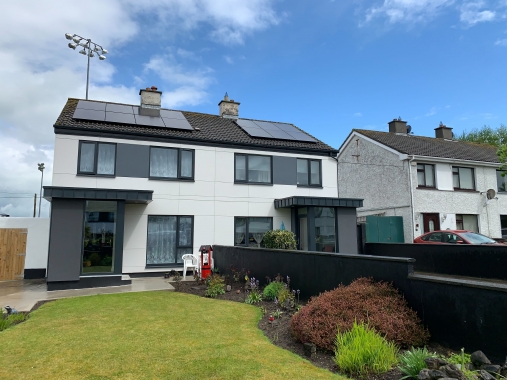Accelerating deep energy retrofit in housing through modular and circular solutions
Reporting from Athlone, Ireland
Athlone, Ireland, 21 September 2023 | Published in Energy, Future of the EU & Housing
This conference organised by Technological University Dublin and Housing Europe in the scope of our EU-funded project, Drive-0 provided an opportunity to examine modular circular renovation and construction solutions in the Irish housing sector and share experiences and lessons learnt from completed Irish and EU pilot projects, which should be of interest to everyone involved in sustainable housing and buildings, notably professionals in building design, construction, manufacture and those involved in housing stock management and policy.
What did we learn?
• Ireland’s position in the transition to a circular economy is still below average when compared to their European peers. In the built environment, typical design and construction are not circular yet at any level, whether applied to building construction or material selection. Most buildings rely on highly unsustainable and extraction-based materials. Awareness of circularity is low in the construction sector and knowledge mostly lies on engineers and contractors.
• The recent ‘Whole of Government Circular Economy Strategy’, ‘Circular Economy Act’ and the ‘Irish National Development Plan’ can take Ireland closer to the European circularity targets for 2030. The circular retrofitting of social and affordable housing will play a major role in the transition of the built environment.
• An important part of the AHB housing stock in Ireland is relatively old, with many small developments located in rural areas that can be a challenge to renovate in a cost-effective way. The majority of AHB tenants living in homes in need of retrofitting are low-income families, older people, those experiencing homelessness, and people with disabilities; many of whom are at risk of fuel poverty.
• Insufficient financing for renovations, the lack of skilled labour, and the higher cost of materials are putting a strain on the renovation of social affordable housing in Ireland.
• A major challenge for the AHB sector in retrofitting is the existing model of income-based, or ‘differential’, rents paid by their tenants. While the model allows for sinking/reserve funds for planned maintenance, it does not allow for new retrofitting standards.
• Building renovation tends not to be cost-neutral and often leads to a zero-sum situation between housing providers and tenants. The ‘Dutch social rent agreement’ provides a good reference for application of cost-neutrality principles in social housing renovation and the management of split-incentives between housing providers and tenants.
• The current grant model used by the AHB sector to finance renovation generates losses. Increased funding levels of AHB retrofitting would enhance retrofitting for the most vulnerable households, as well as ensuring longer life cycle of public housing stock for many future generations.
• To address these challenges, there are several sources of funding available from the EU to help Ireland meet new construction and renovation obligations. More awareness of the EU funding opportunities available to Irish social housing providers is needed. Housing Europe can assist in this matter.
•There are numerous demonstration projects around Europe for modular circular solutions to be used in deep energy retrofit, with evidence of mainstreaming and technical potential. A good example is the EU-funded Drive 0 Irish demonstrator.
• Buildings shall be designed with the future in mind considering factors such as waste; adaptability and deconstruction. In terms of modular circular systems, a hierarchical perspective is required where biobased solutions and design for disassembly are considered at all levels of the building hierarchy, element, component, and product/material.
• The EU Level(s) framework, provides a common language for assessing and reporting on the sustainability performance of buildings. It also offers a simple entry point for applying circular economy principles in the built environment.
• Preparing an off-site mock-up, as well as a parallel audit in Design for Disassembly at all levels is key.
• Forming a stable team for the Irish Case Demonstrator was a challenge. The budget was another obstacle due to an increase in material prices due to unprecedented circumstances such as the coronavirus pandemic and Ukrainian Wars.
• The results of the post-occupancy evaluation showed an improvement in all elements examined, including the reduction of hours in the heating system, air quality, and air draughts, which are three of the most important improvements for tenants, as well as the improvement of domestic hot water, resulting in an alternative heating system.
• When engaging with the tenants, Westmeath County Council focused on highlighting the benefits the intervention. Keeping a continuous flow of information and updating tenants on the progress of the retrofit was key. Above all, minimising disruption was of outmost importance to keep tenants’ interest in the project.
Read the full report below.